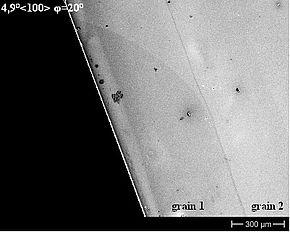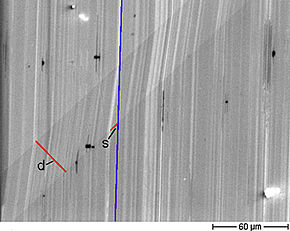Interfaces
The interface between two crystals of different orientation in a single-phase material is called grain boundary. At high temperatures, grain boundaries are mobile under the influence of an applied driving force. The mobility of grain boundaries contributes crucially to processes as recrystallization and grain growth, as well as to texture- and microstructure evolution during annealing. Given the technical importance, the scientific understanding of the underlying mechanisms is still very incomplete.
Our group predominantly researches the mechanisms which are responsible for grain boundary migration and their dependence on grain boundary structure, chemistry and the microstructure of the material. For this purpose, bi- and tri-crystals with a well-defined grain structure are grown in specifically constructed furnaces. From the reaction of the grain boundaries to different driving forces, conclusions about the underlying processes during grain boundary migration on a microscopic scale can be drawn.
To this end, a laboratory for the in situ investigation of grain boundary migration was established which is worldwide unique. It contains several custom-built electron- and polarization-microscope stages allowing the investigation of grain boundaries under various driving forces at high temperature.
Methods
- Growth of bi- and tri-crystals (Al, Cu, Zn, Mg) with exactly defined grain orientation
- Orientation measurement by x-ray diffraction (Laue-method)
- laser powered heating stage for the investigation of grain boundary migration due to capillary driving force
- SEM integrated compression/tension module for stress induced grain boundary migration
- polarization microscope probe for the investigation of Zn bi-crystals in strong magnetic fields
Publications
- D. A. Molodov, U. Czubayko, G. Gottstein, L. S. Shvindlerman, On the Effect of Purity and Orientation on Grain Boundary Motion, in: Acta Materialia 46 (1998), 553-564.
- D. A. Molodov, G. Gottstein, F. Heringhaus, L. S. Shvindlerman, True Absolute Grain Boundary Mobility: Motion of Specific Planar Boundaries in Bi-Bicrystals under Magnetic Driving Force, in: Acta Materialia 46 (1998), 5627-5632.
- T. Gorkaya, D. A. Molodov, G. Gottstein, Mechanically Driven Migration of Symmetrical <100> Tilt Grain Boundaries in Al Bicrystals. Acta Materialia 57 (2009), 5396-5405.
- D. A. Molodov, N. Bozzolo, Observations on the effect of a magnetic field on the annealing texture and microstructure evolution in zirconium, in: Acta Materialia 58 (2010), 3568–3581.
- Y. Lü, D. A. Molodov, G. Gottstein, Recrystallization kinetics and microstructure evolution during annealing of a cold-rolled Fe-Mn-C alloy, in: Acta Materialia 59 (2011), 3229-3243.
- T. Gorkaya, K. D. Molodov, D. A. Molodov, G. Gottstein, Concurrent grain boundary motion and grain rotation under an applied stress, in: Acta Materialia 59 (2011), 5674-5680.
- C. Günster, D. A. Molodov, G. Gottstein, Migration of Grain Boundaries in Zn, in: Acta Materialia 61 (2013), 2363-2375.
- A. A. Saleh, Chr. Haase, E. V. Pereloma, D. A. Molodov, A. A. Gazder, On the evolution and modelling of Brass-type texture in cold rolled TWIP steel, in: Acta Materialia 70 (2014), 259-271.
- C. Haase, L. A. Barrales-Mora, F. Roters, D. A. Molodov, G. Gottstein, Applying the texture analysis for optimizing thermo-mechanical treatment of high manganese twinning-induced plasticity steel, in: Acta Materialia 80 (2014), 327-340.
- J.-E. Brandenburg, L. A. Barrales-Mora, D. A. Molodov, On migration and faceting of low angle grain boundaries: Experimental and computational study, in: Acta Materialia 77 (2014), 294-309.






